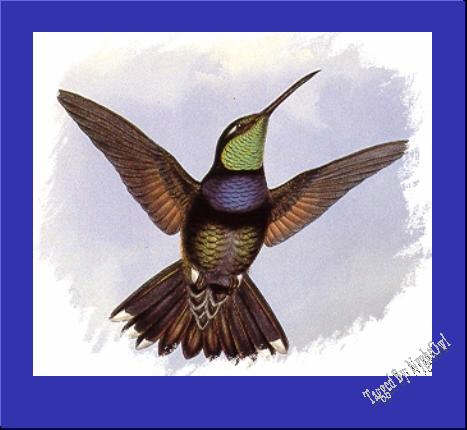Native American Mythology

Hummingbirds are found only in the western hemisphere, so they are absent from the traditional fairy tales, legends, and myths of European and African Americans.
There is, however, a rich supply of stories about these tiny birds in Native American mythology.
A Mayan legend says the hummingbird is actually the sun in disguise, and he is trying to court a beautiful woman, who is the moon.
Another Mayan legend says the first two hummingbirds were created from the small feather scraps left over from the construction of other birds. The god who made the hummers was so pleased he had an elaborate wedding ceremony for them.
First butterflies marked out a room, then flower petals fell on the ground to make a carpet; spiders spun webs to make a bridal pathway, then the sun sent down rays which caused the tiny groom to glow with dazzling reds and greens.
The wedding guests noticed that whenever he turned away from the sun, he became drab again like the original gray feathers from which he was made.
A third Mayan legend speaks of a hummingbird piercing the the tongue of ancient kings. When the blood was poured on sacred scrolls and burned, divine ancestors appeared in the smoke.
A Mojave legend tells of a primordial time when people lived in an underground world of darkness. They send a hummingbird up to look for light. High above them the little bird found a twisted path to the sunlit upper world where people now live.
There is a legend from the Jatibonicu Taino Tribal Nation of Puerto Rico about a young woman and a young man, who were from rival tribes. Like Romeo and Juliet, they fell in love, precipitating the intense criticism of their family and friends.
Nevertheless, the two of them found a way to escape both time and culture. One became a hummingbird and the other a red flower. The Taino Indians also take the hummingbird to be a sacred pollinator, whose mission is to bring an abundance of new life.
To the Chayma people of Trinidad, hummers are dead ancestors, so there is a taboo against harming them. An extinct Caribbean tribe called the Arawacs thought it was Hummingbird who brought tobacco. They called him the Doctor Bird.
In a Navajo legend a hummer was sent up to see what is above the blue sky. It turns out to be absolutely nothing.
In a Cherokee story, a medicine man turned himself into a hummingbird to retrieve lost tobacco plants.
In another Cherokee story, a woman is courted by both a hummingbird and a crane. She first chooses the hummingbird for his good looks, but the crane convinces here that there should be a race around the world with the winner having her hand in marriage.
She agrees, thinking the hummingbird is bound to win because he flies so fast. What she fails to take into account is that Crane can fly all night long, while Hummingbird is able to fly only during the day. Crane wins, but she reneges on her promise, because he is so ugly.
The Creek Indians have a similar story. In this version Crane wins because he flies in a straight line, while Hummingbird zigzags.
Hopi and Zuni legends tell of hummingbirds intervening on behalf of humans, convincing the gods to bring rain. Because of this, people from these tribes often paint hummingbirds on water jars.
The Hopi kachina for Hummingbird depicts him with green moccasins and a green mask. He has an aqua body, and he is yellow on top of the head. His crowned with a ruff made of Douglas fir.
One of the Hopi stories is about a time of famine when a young boy and girl were left alone while their parents were searching for food. After the boy made a toy hummingbird, his sister threw it into the air. It came to life and began to provide for them by bringing an ear of corn every day.
Eventually, the hummingbird flew to the center of the earth where it pleaded with the god of fertility to restore the land. Rain and green vegetation came, then the children's parents returned.
In a Pima legend a hummingbird acted like Noah's dove, bringing back a flower as proof the great flood was subsiding.
There is a legend from Mexico about a Taroscan Indian woman who was taught how to weave beautiful baskets by a grateful hummingbird to whom she had given sugar water during a drought. These baskets are now used in Day of the Dead Festivals.
 Free Forum Hosting
Free Forum Hosting